Hasegawa 1/32 P-40E 'Aleutian Tiger'
|
KIT #: |
08211 |
|
PRICE: |
3,680 yen |
|
DECALS: |
Three options |
|
REVIEWER: |
Tom Cleaver |
|
NOTES: |
Limited release kit |
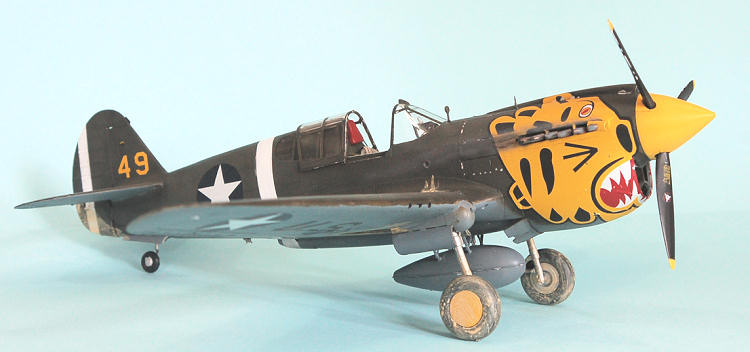
Six days after the
Pearl Harbor
attack, on
December 13, 1941,
Major John Chennault left
Selfridge Field,
Michigan,
headed for McClellan Army Air Depot in
Sacramento,
California,
at the head of 24 Army Air Forces would-be fighter pilots.
Their orders were to pick up Curtiss P-40Es and head for
Alaska
to join the 18th Pursuit Squadron
and provide air defense for the territory.
At McClellan, they found half the P-40Es were still
“pickled.”
After raising hell, the technicians at the air depot worked
around the clock to ready the Warhawks, and by the first week in January 1942,
they were ready.
As Chennault later recalled, “We started out in January, 1942,
and the situation was like this: my three flight commanders each had less than
eight months’ experience since graduating flight school; 18 of my younger pilots
averaged less than 8 hours apiece on the P-40, the others had less than three.”
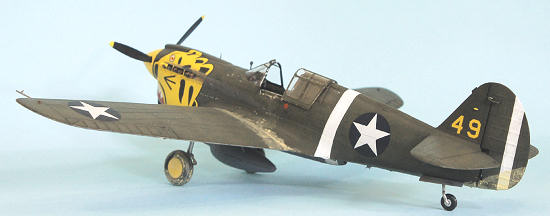 Two of the P-40s were out of action before the group got
out of
California,
with five more lost enroute to their destination at
Fairbanks,
Alaska.
Once there, they found conditions were worse than
“primitive.”
“This was the first time modern fighters had operated in
Alaska
and the airfields were nothing but cleared spaces in the wilderness.
We fueled our planes from drums with pumps, slept in
crude huts and froze all the time.”
Two of the P-40s were out of action before the group got
out of
California,
with five more lost enroute to their destination at
Fairbanks,
Alaska.
Once there, they found conditions were worse than
“primitive.”
“This was the first time modern fighters had operated in
Alaska
and the airfields were nothing but cleared spaces in the wilderness.
We fueled our planes from drums with pumps, slept in
crude huts and froze all the time.”
By
June 3, 1942,
the pilots had come to understand that flying conditions were terrible
throughout
Alaska,
a part of the world that could lay claim to some of the worst weather conditions
anywhere: dense fogs that arrived without warning and “williwaws,” high winds
that arrived with intense winter cold.
Mechanical items showed unusual behavior at 40 degrees
below zero. Oil became almost solid, metal and rubber became brittle and
fractured easily. The “airfields” were little more than muddy clearings, while
the long distances between rudimentary air bases coupled with the complete
absence of aerial navigation aids made what flying was possible nearly
impossible and certainly dangerous at all times.
In April 1942, Life Magazine published a major publicity
article by Claire Boothe Luce about the “Flying Tigers,” the American Volunteer
Group commanded by John Chennault’s father.
As a result, the 11th
Pursuit Squadron decided to call themselves the “Aleutian Tigers,” and a
distinctive tiger design was created as their insignia, worn on the noses of the
P-40Es.
As with the Tiger markings of the AVG, no two of these were exactly the
same.
As part of the attack on
Midway
Island,
a carrier-based Japanese task force centered around the light carriers
Junyo and Ryujo
was sent to attack
Alaska
and invade two islands in the Aleutian chain,
Attu
and Kiska.
On
June 3, 1942,
attacked
Fort
Mears
and
Dutch
Harbor.
P-40S were scrambled from
Fort
Randall,
but the Japanese were gone by the time they reached
Dutch
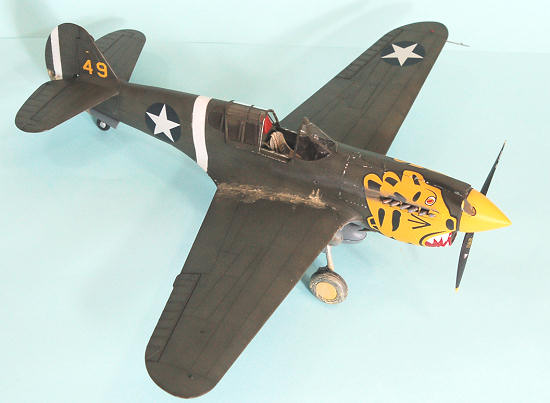 Harbor.
On June 4, the Japanese again hit
Dutch
Harbor,
but the P-40s were ready and one bomber was shot down.
Unknown at the time, the anti-aircraft fire also holed
the gas tank of one of the escorting Zeros, which would crash land on Akutan
Island to become one of the most valuable prizes of the war when it was
discovered and brought to the United States to be exhaustively test-flown.
Harbor.
On June 4, the Japanese again hit
Dutch
Harbor,
but the P-40s were ready and one bomber was shot down.
Unknown at the time, the anti-aircraft fire also holed
the gas tank of one of the escorting Zeros, which would crash land on Akutan
Island to become one of the most valuable prizes of the war when it was
discovered and brought to the United States to be exhaustively test-flown.
The
Attu-Kiska
Campaign now began as the Japanese occupied these two islands on June 7, 1942.
It would last more than a year before the Japanese were
expelled from the two most westerly islands in the Aleutian archipelago, their
only conquests of American territory.
Air raids against the main base on Kiska began in July,
1942.
Operations were difficult, due to the extreme weather in the Aleutians,
and many missions were scrubbed or aborted due to weather throughout the
campaign.
On August 30th, US
Army troops landed on Adak in a howling gale.
By September 10, a PSP runway had been constructed and
the fighter force, by now expanded from the 95 P-40s on hand June 4 to include a
squadron of P-39s and another of P-38s, began moving forward to bring Attu and
Kiska within range.
The first raid, a strafing attack by P-38s, P-39s and
P-40s led by Major Chennault, hit Attu on September 11, 1942.
On September 25, 1942, nine B‑24 Liberators, 12 P‑39
Airacobras and 20 P‑40 Warhawks attacked Kiska. Four of the P‑40s were flown by
RCAF pilots from 111 (Fighter) Squadron, RCAF, in company with the 16 P-40s of
the 11th Fighter Squadron (as the
11th PS had been renamed in May),
now part of the newly-formed 343rd
Fighter Group.
Taking off from the forward airstrip in Adak Island just
before noon, the raiders attacked gun positions, ships, a radar installation and
the main camp, with the P-39s using their heavy armament for strafing.
Two A6M2-N “Rufe” floatplane fighters attempted to
attack the P-40 escorts.
RCAF Squadron Leader Ken Boomer attacked the leader and
shot it down in flames, the only “home” victory scored by an RCAF pilot outside
of the European and Mediterranean Theaters.
Major Chennault shot down the wingman a moment later.
For his action, Squadron Leader Boomer was awarded the
U.S. Air Medal and the British
DFC.
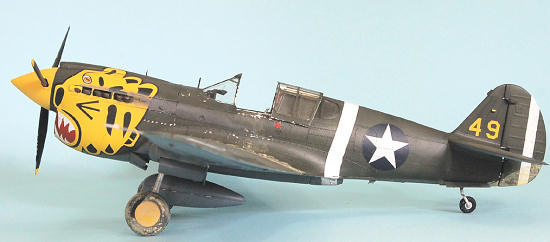 In January 1943, Amchitka Island was occupied and a new
air base constructed, which allowed attacks against Kiska to begin that
February.
In January 1943, Amchitka Island was occupied and a new
air base constructed, which allowed attacks against Kiska to begin that
February.
Eventually, on May 11, 1943, an American invasion force
of 12,000 troops attacked Attu and faced fanatic Japanese resistance in an 18
day battle in which the Japanese lost 2,380 dead and 28 taken prisoner. American
losses were 552 dead and 1,140 wounded.
The costly victory boded ill for the final invasion of
Kiska.
On July 27, 1943. A USN battleship task force began softening up the
fog-shrouded target.
When a force of 34,000 U.S. and Canadian troop finally
landed on August 15, they discovered the Japanese had abandoned the island,
evacuating 5,000 troops under cover of darkness on July 28.
The 343rd
Fighter Group and its component squadrons were inactivated in August 1944, with
the Japanese no longer a threat to Alaska.
Hasegawa has done a good job of releasing kits of the
Allison P-40s.
This limited release P-40E provides the separate parts to create
an early P-40E.
The major visual clue is the lack of protruding gun tubes in the
wings.
The kit also replaces the incorrect windscreen of the first P-40E
releases with the correct windscreen.
With the parts in this kit, any P-40E, P-40E-1, P-40E-5,
P-40K-1 or P-40K-5 can be done.
The decals provide “Aleutian Tiger” markings for three
different aircraft of the 11th
Fighter Squadron in 1942.
All the Hasegawa P-40s go together similarly.
I find that it’s best to attach the tails to the
fuselage halves before gluing the halves together, since you can work on them
from both sides to get a good smooth joint.
You have to make that seam disappear, so getting it
right at the beginning makes everything a lot easier.
Ditto the rear canopy glass. I paint the interior piece
the exterior camouflage color, then glue it in position, then glue that half of
the glass.
Again, you have a seam around the lower rear and the aft joints
that has to disappear, and doing it this way also allows for a good joint to
start with.
I used Tamiya “Mr. Surfacer for these joints and get them to
disappear before gluing the fuselage halves together.
It can take a couple applications and sandings, and you
have to be very careful you have gotten the seams to disappear, because they
show up r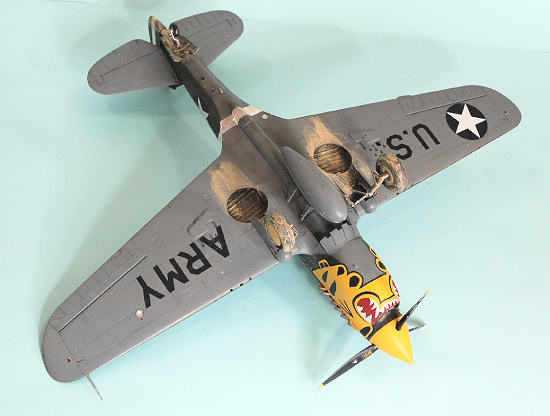 eally
obviously under a coat of paint.
I rescribe the panel lines and then rescribe the rivet
lines with a pounce wheel.
eally
obviously under a coat of paint.
I rescribe the panel lines and then rescribe the rivet
lines with a pounce wheel.
While all that is setting up, I assemble the wing.
Again, it’s good to take your time getting the gun plug
to fit right in the leading edge of the wing, because you have to make that
disappear.
Once they’re set, I sand down those plugs, then use the Tamiya
surfacer and then sand them down again until they are gone.
They make you look stupid if they reappear.
I also attach the various cowling panels at this point.
For this early P-40, you want to make the forward plug
just ahead of the exhausts disappear, so do the same thing you did with all
those other fershlugginah seams, You then rescribe the two main panel lines
above and below the exhaust outlets all the way to the nose.
Once all this was done, I inserted the radiator assembly
in the nose and glues it in position, then glues the fuselage halves together
without the cockpit.
I then took care of the doggone centerline seams, same
way as the others.
While all that was setting up, I assembled the cockpit.
I did some “weathering” with dry-brushed Tamiya Flat
Aluminum, Tamiya “Smoke,” and then “muddied” the cockpit floor with the Tamiya
weathering set.
Hey, it’s an airplane that was likely parked in a muddy bog, so
it will get dirty inside and out.
The cockpit will snap into place, after which I attached
the wing.
I find these kits always need some Tamiya surfacer on the upper
wing-fuselage joint.
With that done, I attached the horizontal stabs, the
rudder, and the cockpit windscreen, which I painted flat black inside.
After pre-shading the model along panel lines with
airbrushed flat black, I painted the lower surfaces with Tamiya “Neutral Grey.”
The upper surfaces called for some additional effort.
These P-40s were done in the pre-war Olive Drab, which
is a green-base paint.
I have seen “Glacier Girl” up close, an
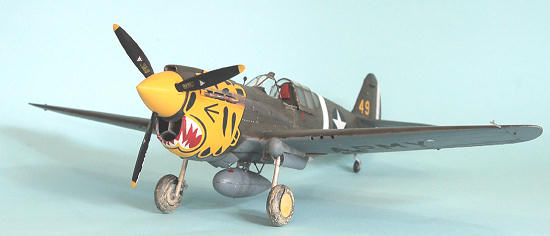 airplane
that was restored in paint matched to the original colors it was found with.
This is a green color very close to British RAF Dark
Green, with a bit more dark olive cast.
I gave the model a preliminary coat of Tamiya “Olive
Drab,” then went over it and blotched it with Tamiya RAF Dark Green.
I then thinned the RAF Dark Green and went over the
whole upper surfaces.
These airplanes didn’t fade (there wasn’t any sun) but
they did get weathered and from the few photos I have seen they look pretty beat
up.
I then applied some light grey to the paint and went over the fabric
control surfaces.
When all was dry, I gave the model an overall coat of
Xtracrylix Clear Gloss.
airplane
that was restored in paint matched to the original colors it was found with.
This is a green color very close to British RAF Dark
Green, with a bit more dark olive cast.
I gave the model a preliminary coat of Tamiya “Olive
Drab,” then went over it and blotched it with Tamiya RAF Dark Green.
I then thinned the RAF Dark Green and went over the
whole upper surfaces.
These airplanes didn’t fade (there wasn’t any sun) but
they did get weathered and from the few photos I have seen they look pretty beat
up.
I then applied some light grey to the paint and went over the fabric
control surfaces.
When all was dry, I gave the model an overall coat of
Xtracrylix Clear Gloss.
I used the kit decals.
These are thick and I needed several coats of Solvaset
to put them in place.
I think if I did this again, I would use this kit (since
it has the correct small details), and get Roy Sutherland’s P-40 decal sheet
that has these markings, since those decals are thinner and better.
In the end, after a lot of effort, the decals looked OK.
I gave the model several coats of Xtracrylix Flat coat
to get a dead flat finish, which is what the photos of airplanes in this unit
show they looked like after a few months of being out in the Alaskan weather.
I “dinged” the airframe with Tamiya “Flat Aluminum,” and
then applied exhaust and oil stains with Tamiya “Smoke.”
I also “muddied” the wheels and the wheel wells with the
Tamiya weathering set.
After that, I attached the exhaust stacks, the wheels
and gear doors, and the prop.
I unmasked the canopy and posed it open.
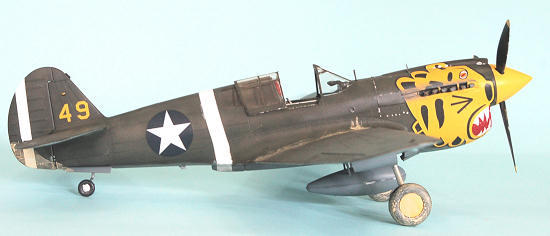 The “Aleutian Tiger” is a very distinctive-looking model
when finished. Kudos to Hasegawa for checking the few photos available and doing
their research to get things like the gun tubes and the exhausts right for a
very early P-40E.
While the kit decals are acceptable, I would definitely
recommend the Barracuda Decals set.
Using this particular limited-release kit, it would also
be possible to do such other early P-40Es as that flown by Boyd “Buzz” Wagner in
the Philippines, who became America’s first official “ace” of World War II.
I wish Hasegawa would do the Merlin P-40s on their own,
but with the Greymatter Conversion set, and with limited-release kits like this
and the P-40K, it is possible to do the complete line of P-40 Kittyhawk/Warhawk
sub-types.
Highly recommended for P-40 fans.
The “Aleutian Tiger” is a very distinctive-looking model
when finished. Kudos to Hasegawa for checking the few photos available and doing
their research to get things like the gun tubes and the exhausts right for a
very early P-40E.
While the kit decals are acceptable, I would definitely
recommend the Barracuda Decals set.
Using this particular limited-release kit, it would also
be possible to do such other early P-40Es as that flown by Boyd “Buzz” Wagner in
the Philippines, who became America’s first official “ace” of World War II.
I wish Hasegawa would do the Merlin P-40s on their own,
but with the Greymatter Conversion set, and with limited-release kits like this
and the P-40K, it is possible to do the complete line of P-40 Kittyhawk/Warhawk
sub-types.
Highly recommended for P-40 fans.
Tom
Cleaver
August 2011
Copyright ModelingMadness.com. All rights reserved. No reproduction in part or in whole without express permission.
If you would like your product reviewed fairly and fairly quickly, please contact the editor or see other details in the
Note to
Contributors.
Back to the Main Page
Back to the Review
Index Page


 Two of the P-40s were out of action before the group got
out of
Two of the P-40s were out of action before the group got
out of  Harbor
Harbor
 eally
obviously under a coat of paint.
I rescribe the panel lines and then rescribe the rivet
lines with a pounce wheel.
eally
obviously under a coat of paint.
I rescribe the panel lines and then rescribe the rivet
lines with a pounce wheel. airplane
that was restored in paint matched to the original colors it was found with.
This is a green color very close to British RAF Dark
Green, with a bit more dark olive cast.
I gave the model a preliminary coat of Tamiya “Olive
Drab,” then went over it and blotched it with Tamiya RAF Dark Green.
I then thinned the RAF Dark Green and went over the
whole upper surfaces.
These airplanes didn’t fade (there wasn’t any sun) but
they did get weathered and from the few photos I have seen they look pretty beat
up.
I then applied some light grey to the paint and went over the fabric
control surfaces.
When all was dry, I gave the model an overall coat of
Xtracrylix Clear Gloss.
airplane
that was restored in paint matched to the original colors it was found with.
This is a green color very close to British RAF Dark
Green, with a bit more dark olive cast.
I gave the model a preliminary coat of Tamiya “Olive
Drab,” then went over it and blotched it with Tamiya RAF Dark Green.
I then thinned the RAF Dark Green and went over the
whole upper surfaces.
These airplanes didn’t fade (there wasn’t any sun) but
they did get weathered and from the few photos I have seen they look pretty beat
up.
I then applied some light grey to the paint and went over the fabric
control surfaces.
When all was dry, I gave the model an overall coat of
Xtracrylix Clear Gloss.